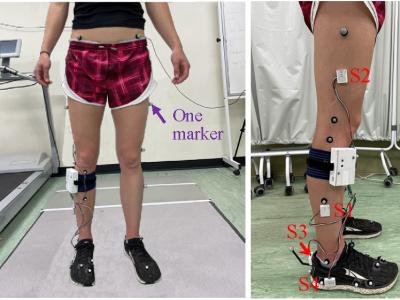*.csv
Sensor arrays are ubiquitous. They capture images in digital cameras, record the swipes of our fingers on the screens of our phones and tablets, or map pressure distribution over an area. Soft capacitive sensor arrays have been proposed to make electronic pressure-sensing skins capable of identifying the location and intensity of touch. However, large arrays of those sensors remain challenging to produce, as they require high-resolution patterning of electrodes and routing of long and thin electrical connections.
- Categories:
 198 Views
198 ViewsIMUs have gained popularity for tracking joint kinematics due to their portability and versatility. However, challenges such as limited accuracy, lack of real-time data analysis, and complex sensor-to-segment calibration procedures have hindered their widespread use. To address these limitations, we developed a portable system that integrates four IMUs to collect treadmill walking data, with ground truth values obtained from a Motion Capture System.
- Categories:
 128 Views
128 Views
Text classification systems have become increasingly important in recent years due to the explosion of online documents and the need to sort them for specific services. One of the most critical issues in text classification is the limited availability and diversity of datasets, which can lead to overfitting and poor generalization. In this context, we present a new dataset named Global News 60K (GN60K), which consists of 60,000 news articles from different sources from different parts of the world, covering 10 topics.
- Categories:
 274 Views
274 Views
Readily available animal tissue such as ground beef is a convenient material for mimicking the dielectric properties of biological tissue when validating microwave imaging and sensing hardware and techniques. The reliable use of these materials depends on the accurate characterization of their properties. Tissue water content is a dominant factor in microwave frequency tissue properties, thus the effect of dehydration must be considered. The dependence of tissue properties on hydration is also important for new applications of microwave sensing for hydration monitoring.
- Categories:
 41 Views
41 Views
Field frequency data of three real event cases from SMD-Ls.
Case 1: a fast event.
At 17:21:31 on March 18, 2020, the second-line circuit breaker in Shanan, Jibei, China tripped. The valid SMD-L data points in the AC network of North China are in place H, Z, X, and N.
Case 2: a slow event.
- Categories:
 25 Views
25 ViewsThis dataset has EV charging data from 2019 to the present day. SFU's Burnaby campus currently has two different types of Electric Vehicle Charging Stations on campus. There is no additional charge to use the station; however, the Permit or Daily Rate required in each lot remains in effect for the EV Reserved stalls.
- Categories:
 454 Views
454 Views
The B2F dataset (Biometric images of Fingerprints and Faces) has been prepared for face and fingerprint recognition, verification or classification.
The first subset (Fingerprint): This set of data presents the five finger feature vectors (of the left hand) for each person in a csv files.
The second subset (Face): This set of data presents feature vectors of face images in csv files. Feature vectors were extracted using the model (ResNet-50 + ArcFace). This set of face feature vectors represents:
- Categories:
 1775 Views
1775 Views
To utilize a quantum annealing system such as D-Wave's to solve a graph coloring problem,
it is necessary to convert the utility polynomial into a quadratic polynomial in binary variables.
This is called QUBO (quadratic unconstrained binary optimization) problem.
In any degree reduction process, we need to introduce auxiliary variables,
and more variables we have in the QUBO problem, less likely a
quantum annealing system can find an optimal solution.
The current degree reduction methods applies to monomials.
- Categories:
 5 Views
5 ViewsThis Data set was obtained from a Hospital in Karaikudi, Tamilnadu Iindia, and has 400 insstances with 25 attributes, intended for classification problems.
The Data Set has medical relevant variables that can be associated to the presence of CKD (Chronical Kidney Diasease). Some of the variables can be arguably more relevant for the model, and after analysis some of them can be correlated, so it's recommended to analyze the dataset and decide the best approach based on individual needs.
- Categories:
 5477 Views
5477 ViewsThis dataset consists of “.csv” files of 4 different routing attacks (Blackhole Attack, Flooding Attack, DODAG Version Number Attack, and Decreased Rank Attack) targeting the RPL protocol, and these files are taken from Cooja (Contiki network simulator). It allows researchers to develop IDS for RPL-based IoT networks using Artificial Intelligence and Machine Learning methods without simulating attacks. Simulating these attacks by mimicking real-world attack scenarios is essential to developing and testing protection mechanisms against such attacks.
- Categories:
 4466 Views
4466 Views


